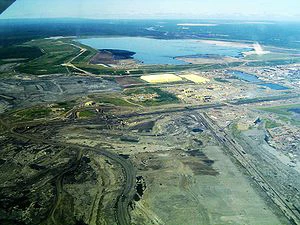
This declaration understandably attracted considerable attention from climate policy-watchers because Canadian oil sands (also commonly referred to as “tar sands” reflecting the heavy, molasses like quality of the substance) are the resource proposed for transmission via the controversial Keystone XL pipeline recently denied a permit by the Obama Administration. (Oil sands deposits have also been found in Russia, Venezuela and Kazakhstan, but a majority of identified reserves and virtually all commercial production are in Canada.)
Some advocates for developing the oil sands see their use as essentially a national energy security issue, maintaining the pipeline is an important step forward toward fulfilling the long cherished dream of US energy independence, not to mention the potential to reduce or at least stabilize gasoline prices: ``Is US Energy Independence Finally Within Reach”, National Public Radio, March 7, 2012.
To be sure, the promise of lower gasoline prices and energy security are strong considerations. But an ongoing debate continues as to whether or not this economically attractive resource can be extracted, refined, and distributed without unacceptable environmental harm. This is why an otherwise academic analysis by Neil Swart and Andrew Weaver at the University of Victoria in British Columbia proved newsworthy. They calculated the global temperature rise that would result from the carbon dioxide released by burning currently proven reserves of Canadian oil sands: Neil Swart and Andrew Weaver, “The Alberta oil sand and climate,” Nature Climate Change, Feb. 19, 2012.
In the article’s narrow analysis, the story focused on the simplistic conclusion that relative to global reserves of coal and natural gas, burning currently proven reserves of oil sands would contribute only about a thirtieth as much carbon dioxide and raise global temperatures about half a degree C.
Unfortunately, this summary quote, by itself, is insufficient to allow a conclusion as to whether development of the tar sands is or is not acceptable from a climate perspective. As such, it provides no useful guidance to a policy maker.
Indeed, whether or not to develop tar sands is a complex issue and no doubt difficult to reduce to a single newspaper article. On the one hand, the relevant national and state governments typically make several points in making the case that greenhouse gas emissions from tar sands are acceptable. For example: they emphasize their expectation that total national emissions are still expected to decline modestly based on reductions in other sectors. One often hears as well that relative to total national emissions, oil sands are less than 10%. And there is also the argument that the carbon intensity of oil sands production has been declining and will continue to do so with improvements in technology.
Not surprisingly, tar sand critics challenge these arguments. Climate scientist James Hansen has noted that focusing on any individual source of fossil fuel production would show the same result: “Every single source, even Saudi Arabia, is small compared to the total.”: Partington, Weaver and Swart study shows tar sands emissions still a problem,” The Pembina Institute, Feb. 27, 2012.
A more fundamental concern from the climate science community, however, is that the current trend in emissions growth is already unsustainable – meaning major new financial commitments to develop any additional carbon sources will only worsen the problem. As the International Energy Agency concluded in its 2011 World Energy Outlook, if we go on building high-carbon energy generation, then by 2015 at least 90% of the available "carbon budget" – based on a 450 ppm scenario -- will be fully consumed. By 2017, the whole of the "carbon budget" will be gone and the costs of emission reductions will accelerate. The OECD recently concluded in its Environmental Outlook to 2050 that without new policies world energy demand in 2050 will be 80%higher, leading to a 50% increase in GHG emissions.
Even the authors of the study behind the headline themselves have written “It would be a huge mistake to interpret our results as some kind of a “get out of jail free” card for the tarsands…the world needs to transition away from fossil fuels. That means coal, unconventional gas and unconventional oil all need to be addressed.” Read The oil sands are symptom of the bigger problem of our dependence on fossil fuels,” Feb. 21, 2012.
In short, while their security and economic value continues to make new carbon intensive fuel sources attractive, the study does not contradict established wisdom with respect to the shared global need for the accelerated adoption of renewable and other non-fossil energy sources. This conclusion may not make headlines, but it’s still important news.


Join the Conversation